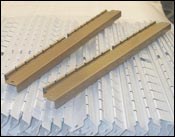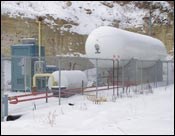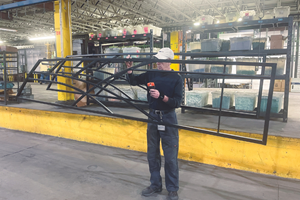Leaner and Greener
Minnesota shop focuses on lean manufacturing, energy conservation
Ted Schreyer, VP of Operations at Associated Finishing Inc. (AFI), sums up business conditions for the paint and powder coating shop with a brief history lesson.
“Our biggest customer three years ago got so big they actually put in their own finishing line,” he recalls. “Our biggest customer two years ago went offshore—took their parts to China. Our biggest customer last year is now looking at doing the same thing.
“Not only that, but maybe 10 years ago you had two weeks to turn a job around,” continues Schreyer, a 30-year AFI veteran. “Now it’s more like two days if we’re lucky. So we have to be good at short runs and quick changes.”
Those realities helped shape the operating philosophy of AFI, which started life in 1965 as a project engineering firm. Contract finishing had evolved into the company‘s main revenue source by the early 1970s, and AFI now specializes in providing fast turnaround on both liquid and powder coating jobs.
“Our twin themes are lean and green,” Schreyer says. “We’ve had a lean manufacturing initiative going for the past three years, and our other focus has been on reducing energy costs.”
Evidence of the lean manufacturing program, including 5S organizational tools and visual manufacturing boards, is apparent throughout the shop. Less obvious are the improvements AFI has made to reduce its energy costs and improve energy use flexibility. “We put in a backup generator to cut electricity costs and a backup liquid propane system to reduce natural gas costs, and they’ve allowed us to cut utility costs pretty significantly,” Schreyer says.
“For the LP system, we have an 18,000 gal LP tank and a vaporizer to convert it from liquid to gas,” explains facilities manage Kelly McCabe. “All our equipment can run on either natural gas or LP, so our gas provider can turn us off any time they want. They like that, so we get a better rate.
“It’s the same thing with the electricity. We installed a 500-kW generator and we can be taken off the grid at any time, so we pay a lower rate.”
The result of these initiatives has been annual energy costs savings of 15–20% for the 34,000-sq ft shop, which also provides contract stripping services and silk screening to customers mainly from the Twin Cities area. “We run a 53-ft semi and a 24-ft straight truck to the Minneapolis area and back at least once a day,” Schreyer says. “Our customers include many of the stampers in the Twin Cities area, some OEMs and some die casters, so our parts are a real variety of castings, stampings, weldments, steel, aluminum, zinc—you name it.”
Focus on Pretreatment
Coupled with the imperative to cut energy consumption, that variety of substrate materials has been one of the drivers of AFI’s continued search for a pretreatment for both painted and powder coated parts. The company ran standard iron phosphate for many years and still does on a three-stage belt washer. But settling on cleaning and pretreatment chemistry in the company’s larger washer, a fiberglass unit built in 1997, has been more difficult.
“Ten years ago, we ran a cleaner, city water rinse, iron phosphate, RO water rinse, and a seal rinse or RO water rinse,” Schreyer says. “The cleaner and phosphate stages ran at 140°F. It worked well, but even back then we were looking for ways to address energy costs, and eventually we got into some low-temperature phosphates that worked pretty well at 120°F.
“We also tried polymeric sealers, and we tried silanes,” he continues. “But silanes tend to be pretty specific to the metal and coating type you’re using. We’re a job shop and we run a lot of different substrate materials and coatings, so that didn’t work out very well for us.”
The search for a phosphate alternative gained urgency when the city of Mankato instituted a surcharge based on the amount of phosphate AFI was purchasing. “Minnesota being the Land of 10,000 Lakes, and with so much agricultural runoff of phosphate fertilizers, there’s a lot of concern here about eutrophication and other effects,” Schreyer explains.
Finally, in 2006, AFI tried one of the new, non-phosphate, nanotechnology-based pretreatment formulations based on transition metal chemistry. “You didn’t have to heat it, it didn’t sludge, and it worked pretty well,” Schreyer says. “But, again because of our multiple metal substrates, we had issues with bath life. It would load up with iron and cause flash rusting. Controlling it was also difficult—it required a pretty involved test using a colorimeter, and it took about 20 min to complete.”
Nanotech, Phase 2
Early in 2007, DuBois Chemicals, Surface Finishing (Sharonville, OH), which had been AFI’s main pretreatment supplier for many years, rolled out its own transition metal pretreatment chemistry called Zirconization (see sidebar). Based on a good relationship with DuBois representatives, Schreyer agreed to try the product. AFI has been running the chemistry in its large washer since mid-2007, and Schreyer is pleased with the results.
“It’s pretty robust,” he reports. “The biggest potential issue is with flash rust. If you have parts in the washer and the line stops, you will have rusting. So it’s sensitive to slow-downs or stoppages.”
According to Schreyer, both the cleaner and the pretreatment run very well at low temperatures. “We run it between 85 and 100°F, but we can go higher as well,” he reports. “We get good clean parts. We do a lot of water break testing, mainly because I have a hard time believing it cleans as well as it does at those temperatures.
“We actually have to change the temperature control on the cleaning stage heater, because right now the control we have on there bottoms out at 120°F,” he continues. “We’re manually turning it off and on to keep the temperature down. The Zirconization actually likes things cooler, because you don’t want parts to dry off between stages.”
Schreyer says the product also has other advantages compared with the previous nanotechnology pretreatment. “The DuBois product has a better concentration, so I’m using less,” he says. “There are additives that allow it to be controlled using a normal titration, so I can test it in 30–40 sec.”
AFI’s main cleaning line now consists of five stages: cleaner, city water rinse, reverse osmosis (RO) water rinse, Zirconization and RO rinse. Concentration in both the cleaner and pretreatment stages is 2%, and the system usually requires only 1–2 gal per day of makeup. “Shops that run higher line speeds might run higher concentrations, but our philosophy is based more on part density on the line and quick changeovers,” Schreyer explains. “Our line speeds run 3–5 fpm. Many shops would say that’s slow, but it saves a lot on utilities and floor space.”
That approach also dovetails well with AFI’s other equipment, which includes multiple manual paint and powder booths, batch curing ovens and a 75-ft U-shaped main oven that uses convection with an IR boost to provide curing temperatures to 400°F. “Our specialty is short runs, so we don’t get the big orders that allow us to set up automatic guns and things like that,” Schreyer says. “We do color changes usually in less than five minutes depending on the color. From a black to a black, for example, we can be ready to go in less than a minute.”
Reduced Maintenance
According to Schreyer, the new pretreatment also has fewer maintenance requirements than previous systems, and provides product quality equal to or better than conventional iron phosphate. Daily maintenance consists of checks of cleaner pH and rinse water conductivity once per shift and titration of the pretreatment tank at least once per shift.
“We control conductivity in the third stage rinse water pretty closely,” Schreyer explains. “If it gets much above about 200 ppm total dissolved solids, we add water. Temperature control is also important, especially in the summer. So we monitor and record pH and temperature for the cleaner stage, conductivity in second and third stages, titration and pH for the fourth, and conductivity in the final rinse.
“We dump stage four about every two months, and that’s worked well,” he continues. “The big benefit there is, there’s really no sludge in the tank—just a little bit of residue that rinses out. The chemistry also reduces scale in the washer and clogged nozzles.”
As always, the bottom line is the bottom line. “It used to cost us about $55,000/yr to run iron phosphate, including chemicals, utilities and maintenance costs,” Schreyer says. “We’re estimating the Zirconization process is going to cost us about $22,000 annually. That’s a substantial savings.”
Related Content
Products Finishing Reveals 2023 Qualifying Top Shops
Each year PF conducts its Top Shops Benchmarking Survey, offering shops a tool to better understand their overall performance in the industry. The program also recognizes shops that meet a set of criteria to qualify as Top Shops.
Read MoreAdjusting Current and Voltage When Powder Coating
Which manual powder coating gun setting is better to adjust, voltage or current? Jeff Hale of Gema USA discusses when to use different settings on your powder gun to achieve optimal results.
Read MorePowder Coating Overcomes Post Forming
Six Sigma methodology, open communication, and collaboration produce results for leading boat manufacturer.
Read MoreMasking Solutions Provider CFS Dramatically Expands Capabilities and Capacity
Custom Fabrication & Supplies (CFS) completed a new plant expansion packing 10 times the capacity into twice the space. It dramatically enhances the supplier’s custom capabilities to provide extremely precise and cost-effective masking solutions.
Read MoreRead Next
Education Bringing Cleaning to Machining
Debuting new speakers and cleaning technology content during this half-day workshop co-located with IMTS 2024.
Read MoreA ‘Clean’ Agenda Offers Unique Presentations in Chicago
The 2024 Parts Cleaning Conference, co-located with the International Manufacturing Technology Show, includes presentations by several speakers who are new to the conference and topics that have not been covered in past editions of this event.
Read MoreEpisode 45: An Interview with Chandler Mancuso, MacDermid Envio Solutions
Chandler Mancuso, technical director with MacDermid Envio discusses updating your wastewater treatment system and implementing materials recycling solutions to increase efficiencies, control costs and reduce environmental impact.
Read More
























